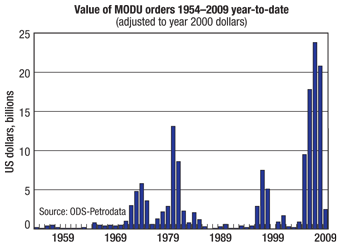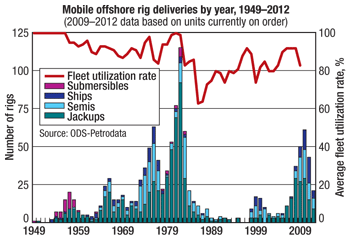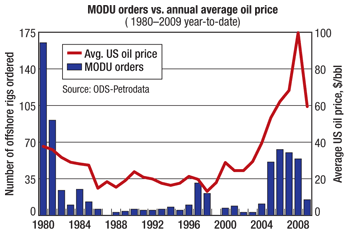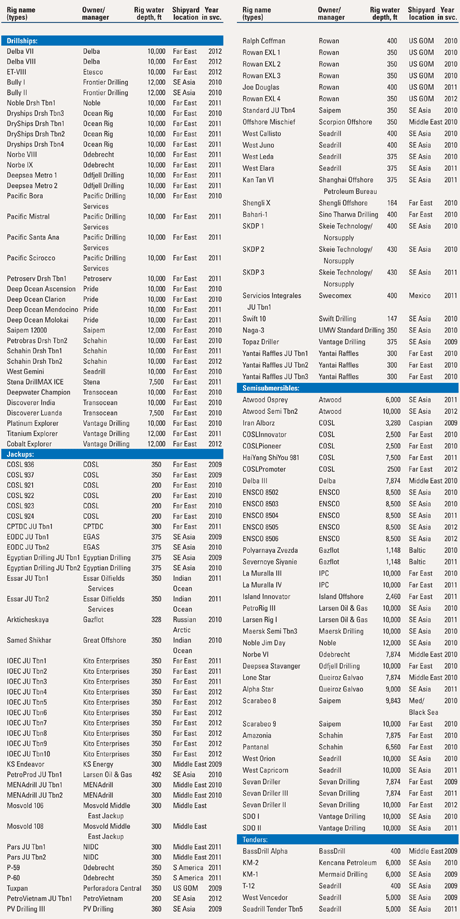Both newbuilds and utilization rates have followed general worldwide economic trends downward in 2009.
Matthew Donovan, ODS-Petrodata
More than a year after the beginning of the global financial crisis, the offshore rig construction boom is clearly over, Fig. 1. A total of 15 rigs have been ordered as of November 2009. In contrast, 59 rigs were ordered in 2006 and 57 rigs were ordered both in 2007 and in 2008. The majority of rigs ordered this year have been jackups, despite an ongoing oversupply situation in many jackup markets.
 |
|
Fig. 1. Demand for mobile offshore drilling rigs cratered in 2009, ending a four-year construction boom.
|
|
The current worldwide mobile offshore rig fleet numbers 744 rigs, comprising 47 drillships, 186 semisubmersibles, 453 jackups and 58 other types. Of these, 83 are cold-stacked, 42 are hot-stacked, 25 are warm-stacked and 13 are out of service. Of the idle units, 121 are jackups.
An additional 111 mobile offshore rigs are under construction, and 30 more are planned. At present, 63 jackups, 37 semisubmersibles and 35 drillships are on order or under construction, Table 1.
This year will see 51 new offshore rigs delivered, assuming reported delivery schedules are met. Thirteen of the rigs with delivery dates in 2009 do not have contract commitments as of early November. Looking into next year, another 65 rigs are expected to be delivered, 31 of them with contract commitments in hand, but the rest without, Fig. 2.
 |
|
Fig. 2. If 2009 delivery schedules are met, 51 new offshore rigs will have been delivered by the end of the year, though 13 of those don’t yet have contract commitments.
|
|
FLEET UTILIZATION TUMBLES
The economic downturn has led to a decrease in offshore rig utilization worldwide. While contracted fleet utilization was at 90.4% in January, it has fallen each month since then, dropping to 78.3% in November.
Looking at utilization by rig type, semisubmersible utilization has fallen less than jackup utilization, declining from 95.8% in January to 87.6% in November. Worldwide drillship utilization has actually increased slightly since early in the year, beginning at 97.6% in January, holding at 97.7% from May to July and reaching a high of 99.0% in September, before dropping to 97.9% in November. All delivered drillships are under contract or have contract commitments lined up.
The real decline in utilization has been in the worldwide jackup market, with the dismal US Gulf market significantly to blame. Jackup utilization has gone from 87.5% at the beginning of the year to a low of 71.2% in August and 72.3% in November. Focusing in on individual markets, jackup utilization in the US Gulf of Mexico cratered during the past year, falling as low as 25.4% in August and still hovering at around 30%. Jackup utilization in Northwest Europe has also declined, going from full utilization in the first four months of the year to 80% by November.
With jackup utilization already low and 63 new jackups ready to enter the market over the next few years, a continued oversupply of jackups is inevitable. Drilling contractors such as Transocean, Hercules Offshore, Seahawk Drilling and Nabors have already cold-stacked 54 jackups worldwide. Further cold-stacking and/or retirement of older units as newer, better-equipped jackups enter the fleet seems likely.
NEW RIG DELIVERIES
The floating rig market is poised to receive 28 new deepwater and six new midwater semisubmersibles over 2010 and 2011. All but 10 of these have multi-year contracts awaiting them on delivery. In the drillship market, 30 new rigs will join the fleet over the next two years, 14 of which have no contract commitments as yet.
Of the 15 rigs ordered in 2009, 10 are jackups ordered by the Iranian Offshore Engineering and Construction Company (IOEC). These rigs will be managed by Kito Enterprises, a Sharjah-based marine and ship management services company. Nine rigs are on order at the ZPMC shipyard in Shanghai and one at the CPLEC shipyard in Liaohe. Construction is expected to begin next year, with delivery by 2012.
Other rigs ordered this year include Sino Tharwa Drilling-managed jackup Bahari-1, Shengli Offshore jackup Shengli X and an unnamed PetroVietnam jackup. These rigs are under construction with delivery dates expected in 2010, 2010 and 2012, respectively. Only Bahari-1 does not have a contract lined up. A tender rig, KM-2, was also ordered by Kencana Petroleum and is expected to be delivered in the first half of 2010.
At present, there are six other planned rigs on which construction has not yet begun and whose completion is in some doubt due to financial issues. Financing for Delba semisubmersibles Delba IV, Delba V and Delba VI has not yet been secured, and the orders have not been finalized. Work on jackups Thule Force and Thule Energy was to begin after the rigs were purchased by Royal Oyster Group, but legal disputes between Royal Oyster, Thule Drilling and Norsk Tillitsmann have brought activities to a halt. RigInvest has paid a deposit for a jackup to be built at the Lamprell shipyard in Sharjah, but it is now looking to sell the rig.
OFFSHORE RIG DEMAND TO RISE
Despite the world’s financial woes, oil prices are on the rise and demand for offshore drilling rigs is expected to increase over the next year, Fig. 3. According to data compiled for ODS-Petrodata’s World Rig Forecast—Short Term Trends report, worldwide demand for offshore drilling rigs will rise by 10–15% in the first three quarters of 2010. The anticipated 55-rig increase in demand will be split about 60/40 between floating units and jackups.
 |
|
Fig. 3. Offshore rig orders have historically followed oil prices.
|
|
However, over the same period, supply will increase by 35 to 40 rigs, so the net effect on fleet utilization will be small. This will have a dampening effect on offshore rig day rates in many markets. 
| TABLE 1. Mobile offshore drilling units under construction or on order |
 |
|
THE AUTHORS
|
| |
Matthew Donovan earned a BA degree in English and Spanish from the University of Texas at Austin. He joined ODS-Petrodata in 2008 as an Associate Editor. He also serves as the North America News Editor for ODS-PetroData’s energy news website, EnergyCurrent.
|
| |
| |
|
|






